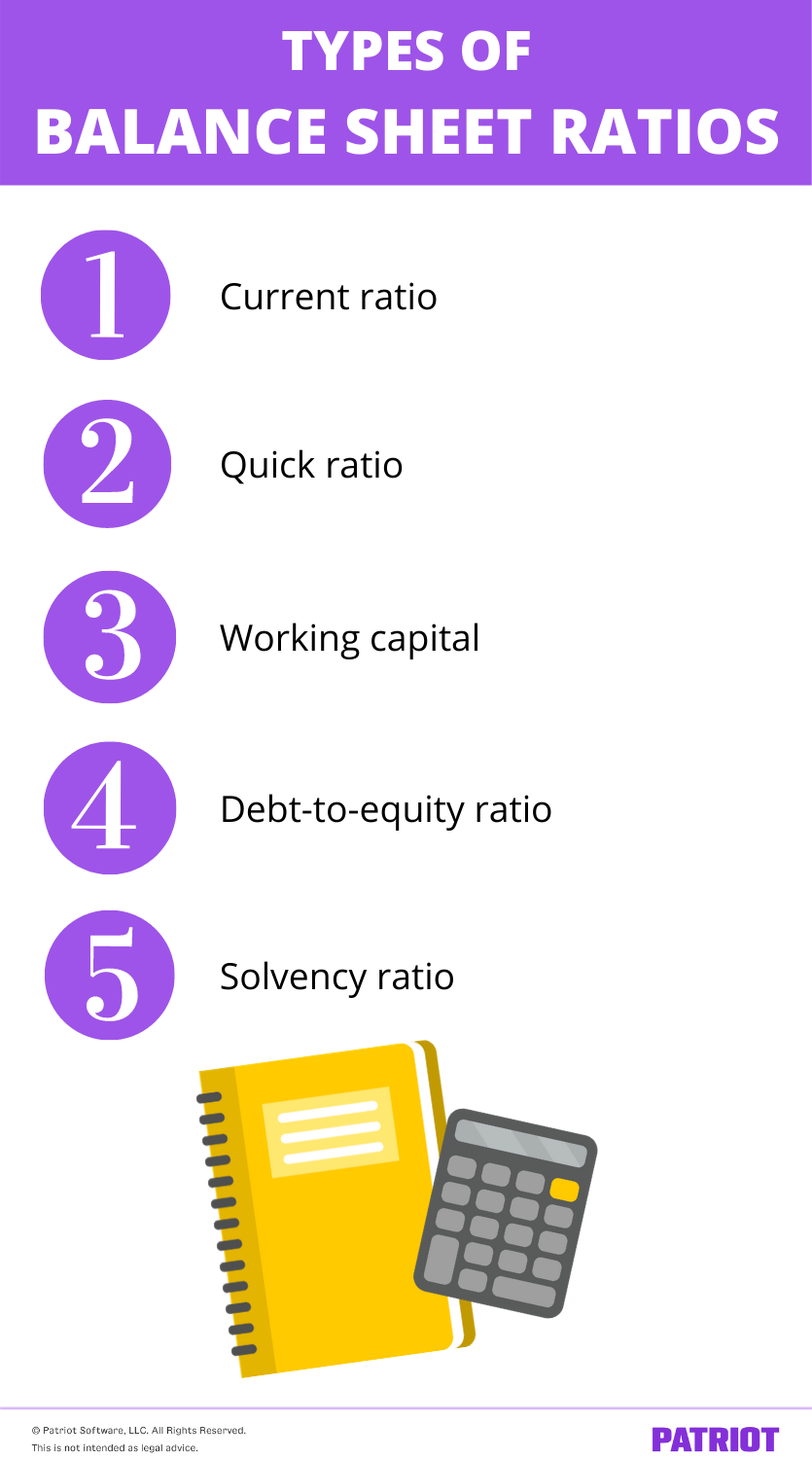Your business’s balance sheet can give you a snapshot of your finances and show you whether you’re on track for success. Without it, you might struggle to detect spikes in spending or see if your pricing strategy is effective.
If you want to take things one step further with your balance sheet and see how your company’s finances are holding up, calculate your balance sheet ratios. Learn more about the balance sheet metrics you should be tracking to keep your finances in order.
Balance sheet overview
Your balance sheet is one of the four basic financial statements. A balance sheet tracks your business’s financial progress and includes three parts:
- Assets (what you own)
- Liabilities (what you owe)
- Equity (amount left over after expenses)
Your balance sheet’s total assets must always equal your total equity and liabilities. If they don’t balance, track down what is causing the discrepancy. When it comes to your balance sheet, you should follow the accounting equation:
Assets = Liabilities + Equity
Your balance sheet shows you a snapshot of your business’s current and future financial health. And, analyzing your balance sheet can give you an idea of where your company stands financially.
Balance sheet ratios
Use balance sheet ratios to further understand your business’s financial standing. Balance sheet ratios are formulas you can use to assess your finances based on your balance sheet information. You can get more insight about your business by looking at and using balance sheet ratios.
Some key balance sheet ratios include (but aren’t limited to):
- Current ratio
- Quick ratio
- Working capital
- Debt-to-equity ratio
- Solvency ratio

Current ratio
The current ratio indicates how well you can liquidate your current assets to pay off your current liabilities. Basically, this ratio measures the liquidity of your company. High liquidity means you can come up with the money for an unexpected expense quickly (without going into business debt).
A current ratio tells you the relationship of your current assets to current liabilities. Current assets are items of value your business plans to use or convert to cash within one year. You pay current or short-term liabilities within one year of incurring them.
To get your current ratio, divide your current assets by your current liabilities. Your current ratio should ideally be above 1:1.
Current Ratio = Current Assets / Current Liabilities
Current ratio example
Say you have $30,000 in current assets and $15,000 in current liabilities. Divide your current liabilities by your current assets to get your current ratio.
Current Ratio = $30,000 / $15,000
Your current ratio would be 2:1. This means you have twice as many assets as liabilities.
Quick ratio
The quick ratio is similar to the current ratio. The only difference between quick and current ratios is that with quick ratios, you must exclude inventory. Inventory can include things like supplies, raw materials, and finished products. Like the current ratio, the quick ratio also analyzes your business’s liquidity.
The quick ratio is more conservative than the current ratio because it removes inventory from the formula. Some businesses prefer to remove inventory from the ratio because carried over inventory cannot necessarily be converted into cash at its book value.
A healthy quick ratio is greater than one. Take a look at the quick ratio formula below:
Quick Ratio = (Current Assets – Current Inventory) / Current Liabilities
Quick ratio example
Let’s take a look at a quick ratio example using the same numbers from the current ratio example. Again, you have $20,000 in current assets and $10,000 in current liabilities. And, you have $2,000 in inventory.
Quick Ratio = ($30,000 – $2,000) / $15,000
Your quick ratio would be 1.87:1, which is not much lower than your current ratio of 2:1. This means that only a small amount of your assets are in inventory, and you have a healthy quick ratio.
Working capital
Working capital is the difference between your current assets and current liabilities. You can use the working capital formula to determine whether or not your business will be able to meet current obligations, like payroll, bills, and loan payments.
Use the working capital formula to calculate how much money you have after you pay off short-term debts (e.g., bills). The amount that’s left is what you have for your day-to-day business operations.
If you have a negative working capital, your business does not have enough money to sustain its business operations.
Investors and creditors may look at your working capital to see if your company can support its expenses and pay off debts.
Your company has no working capital if your current assets equal your current liabilities. A healthy amount of working capital shows that you can take on new debt without drowning. Check out how to calculate working capital below:
Working Capital = Current Assets – Current Liabilities
Working capital example
Say you have $40,000 in current assets and $20,000 in current liabilities.
Working Capital = $40,000 – $20,000
Your business has $20,000 in working capital.
Debt-to-equity ratio
A debt-to-equity ratio shows you how dependent your business is on debt. Debt-to-equity indicates how much equity is available to cover debts. To find this ratio, divide your company’s total liabilities by your total shareholder equity.
Debt-to-equity Ratio = Total Liabilities / Total Shareholder Equity
In many industries, a lower ratio is more favorable. However, the ratio can be difficult to compare across industry groups because amounts of debt for businesses vary. Higher ratios typically indicate a business with higher risk to shareholders.
Debt-to-equity ratio example
Say your business has $40,000 in total liabilities and $25,000 in total shareholder equity.
Debt-to-equity Ratio = $40,000 / $25,000
Your company’s debt-to-equity ratio is 1.6:1. This means your business has $1.60 of debt for every dollar of equity.
Solvency ratio
Use the solvency ratio to see if your business has enough cash flow to pay off long-term debts while also meeting other short-term obligations. The solvency ratio can determine that your finances are healthy enough to pay off long-term debts and still operate.
You can track your solvency ratio month to month to detect problems with your finances. If you see it steadily decreasing over time, your business may have a problem.
Investors and creditors may look at your solvency ratio to find out whether or not your business will survive in the long-term.
Unlike the other ratios you’ve seen, you will need both your balance sheet and P&L statement to calculate your business’s solvency ratio. Use your balance sheet to find your total liabilities.
You must use your P&L statement to find your total net income and depreciation. Depreciation is how much your assets’ values decrease over time.
To find your business’s solvency ratio, use the formula below:
Solvency Ratio = (Total Net Income + Depreciation) / Total Liabilities
If your business doesn’t have depreciation, you can still calculate your solvency ratio using your total net income (Total Net Income / Total Liabilities).
A solvency ratio of 20% or more is generally considered to be good.
Solvency ratio example
Let’s say your business has $25,000 in total net income, $5,000 in depreciation, and $20,000 in total liabilities. Plug in your totals to the solvency ratio formula from above.
Solvency Ratio = ($25,000 + $5,000) / $20,000
Your business’s solvency ratio is 1.5:1, or 150%. With a solvency ratio of 150%, your business should have no trouble paying long-term debts.
Do you need an easy way to record your business transactions? Make your life easier by trying Patriot’s accounting software to track finances. Try it for free today!
Want to inspire our next article? Connect with us on Facebook and let us know your ideas or the questions you want answered!
This is not intended as legal advice; for more information, please click here.



